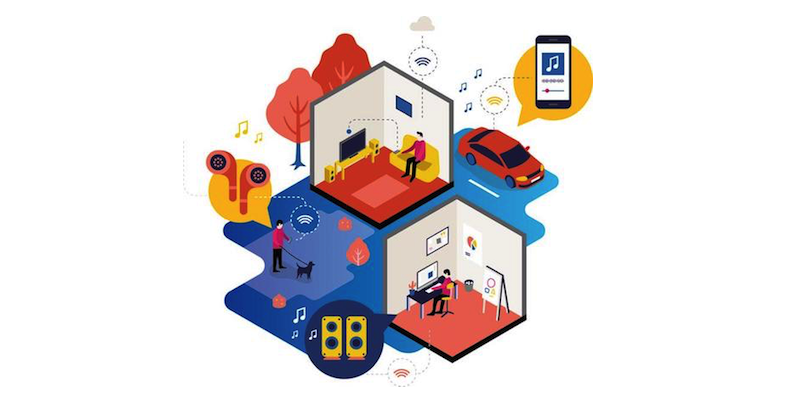The future of personal audio: hearables, voice control, and freedom from wires
The future of personal audio is unfolding rapidly. We are in an era where consumers want more convenience and better quality audio from their devices - as technology innovation challenges the norms for how we use our headphones, these are some of the trends we think will shape the way we access information and experience the soundtracks to our daily lives:
Wires are becoming a thing of the past, and we believe that in the not-too-distant future we’ll use voice to control all sorts of devices.
The rise of voice-activated, connected speakers have helped increase the acceptance of voice as a means of controlling our devices. Improvements in the technologies behind voice control, such as natural language recognition, personalized wake words and far-field voice detection, are helping voice interaction become more robust with the potential for widespread use.

When it comes to wireless connectivity, many Bluetooth connections are now designed to support high-quality sound, and aim to deliver high definition (24-bit) audio, helping to make Bluetooth good enough to replace wires completely. Other forms of wireless connectivity, such as Bluetooth Low Energy, LTE, and Wi-Fi offer alternative connectivity options and are enabling new audio use cases, and we believe true wireless headphones (which offer complete freedom from wires) may well become commonplace.
Thanks to improvements in voice interaction, wireless audio quality, latency, power consumption, and user experience, wireless connections are being designed to support audio at every stage of our day — at home, in our cars, at work, in the gym, or outdoors. We just need to say the word.
The quest for pure, crisp, and high definition sound is becoming ever more mainstream, and many consumers expect very high sound quality in headphones and speakers at all price points. Some streaming music services — now a common way to consume audio —support high-res sound, in response to increased consumer demand for 24-bit audio file types.
The quality of the material used in personal audio devices has improved, which means they can often deliver better sound clarity with less distortion. Furthermore, technologies like Qualcomm aptX HD are engineered to support 24-bit audio via Bluetooth, helping headphones and speakers provide very high quality listening experiences. Other features such as active noise cancellation (ANC) technology are designed to eliminate or significantly reduce external, unwanted sounds so headphone users can concentrate solely on their music. These advancements mean we’re likely to see continued improvement in audio quality and enhanced immersion in personal audio.

While headsets can be a means to tune out, they can also allow us to be more social. Recent technology advances support broadcasting music from one speaker or headset to many, and person-to-person sharing — providing options to listen to audio alone, or share via dual, multicast or broadcast. In the future we hope we’ll be able to listen to (and watch) our media with friends, no matter where we are.

Headsets are similar to speakers when it comes to voice interaction and connectivity — we expect that in the near future we’ll be able to ask our headset questions and get a verbal response. We believe that connected “smart assistant” headphones may be the next phase in personal audio tech. Also known as “hearables”, these headphones or earbuds are designed to be worn all day, use voice interaction, and are connected via a smartphone to provide time-relevant, location-specific information.
With hearables, we should be able to get all kinds of real-time information straight to our in-ear buds, such as live translation, weather, route and schedule updates, and biometric feedback on our health or workout performance.
Some (but not all) of the key technology capabilities necessary to make hearables of the future possible include:
- voice interaction that is always listening and works in noisy environments
- super low power
- high-speed connectivity
- biometric sensors and data processing
These advancements in technology may lead to a widespread uptake of hearables, as consumers are able to enjoy the convenience and immediacy of using voice for daily assistance.

Authored by The OnQ Team









![[Funding alert] Edtech platform BYJU'S raises new round from BOND](https://images.yourstory.com/cs/2/a9efa9c0-2dd9-11e9-adc5-2d913c55075e/byju-21562735903747.jpg)
![[The Turning Point] Need to upskill led couple to launch online learning platform for students and professionals](https://images.yourstory.com/cs/2/79900dd0d91311e8a16045a90309d734/turningpoint-800x400option1-1596174232912.png)
![[Funding alert] Plum raises $35M in Series C round led by A91 Partners](https://images.yourstory.com/cs/2/d72b5ef09db411ebb4167b901dac470c/Imageorxc-1648016620439.jpg)